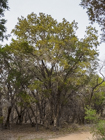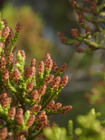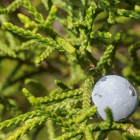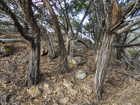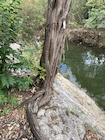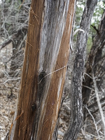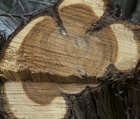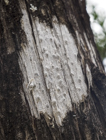Conservation Status

Juniperus ashei
Buchholz (1930)
Common names
Ashe juniper, mountain cedar (Adams 1993), post cedar, rock cedar, Ozark white cedar, Mexican juniper (Farjon 2005).
Taxonomic notes
Type: USA, Arkansas, Sylamore, W. W. Ashe s.n., collected 1924.03.06 [MO-055859], includes pollen and seed cones. There are two recognized varieties, the type and J. ashei var. ovata R.P.Adams. J. ashei is in Juniperus Section Sabina, in the subclade of North American serrate-leaf-margin species (Adams and Schwarzbach 2013, Uckele et al. 2021).
Var. ovata was distinguished as a variety by Adams and Baker (2007) and later raised to species rank by Adams and Schwarzbach (2013) based on nrDNA and cpDNA analysis placing it in a clade with J. saltillensis. That analysis, however, was contradicted by a different genetic analysis using restriction site associated DNA markers (RAD sequencing), which placed ashei and ovata as sister taxa (Uckele et al. 2021). Adams and Baker (2007) summarize the clear morphological and chemical markers separating ashei from ovata. They do not, however, present evidence of the clear reproductive or ecotypical differences that are needed to separate sister taxa at species rank. Moreover, the two taxa hybridize readily through a large area in trans-Pecos Texas (Adams et al. 2020, Uckele et al. 2021). Also, there have been few collections or studies demarcating the distribution of var. ovata. Elevation to species rank is not currently appropriate.
Synonymy for the species: Sabina ashei (J.Buchholz) Y.Yang & K.S.Mao 2022.
Synonymy for var. ashei:
Synonymy for var. ovata: Juniperus ovata (R.P.Adams) R.P.Adams 2013.
Adams (1993) refutes reports of hybridization with J. virginiana or J. pinchotii. Uckele (2021) finds evidence of chloroplast DNA introgression from J. ashei into J. saltillensis and J. arizonica, noting that these taxa may have had a shared distribution during Pleistocene. Adams (1977) elucidated patterns of morphological and chemosystematic markers across the range of J. ashei, and speculated that those patterns arose from differentiation of taxa in northern Mexico during Pleistocene time, with most of the current range of J. ashei marking a very rapid Holocene expansion across most of Texas, into Arkansas and Missouri. These ideas seem reasonable but not much evidence has been advanced since Adams proposed the idea, and genetic approaches still have not provided much clarity regarding the phylogenetics of the taxa involved.
Description
Dioecious large shrub or small tree, 6-10(-15) m tall, usually single-stemmed for basal 1-3 m, up to 50 cm dbh. Branches long, spreading to ascending, forming an open to dense, irregular to rounded crown. Bark on small branches first pink turning gray and flaking; on trunk and large branches brown, weathering gray and exfoliating in thin strips; often the bark bears a gray-white fungus. Foliage branches numerous, irregular, not pendulous. Ultimate branchlets spreading to erect, stiff, 5-10(-20) × 0.9-1.3 mm, 4-sided in cross section (whip shoots occasionally 3-sided), covered with closely appressed leaves, persistent. Leaves on lateral branchlets variably green, scale-like, decurrent, (slightly) imbricate, rhombic, often keeled, acute, with finely denticulate margins, 1-2 × 0.8-1.2 mm, with stomata on the abaxial side limited to decurrent leaf base, on the adaxial surface in two bands; glands obscure, resembling a small pimple, terminating a single resin cavity, without exudate. Pollen cones numerous, terminal, solitary, subglobose to ovoid, 2-4 x 2 mm, yellow-green maturing to pink or light brown. Seed cones maturing in 1 year, terminal on straight short branchlets, young cones pink glaucous, maturing dark blue, globose to broadly ovoid, 6-10 mm, succulent and resinous, with 1-2(-3) seeds. Seeds broad ovoid, 4-6 x 3-4.5 mm, not flattened, lustrous yellow-brown to chestnut brown, with a lighter hilum. Cotyledons 2, juvenile leaves restricted to seedlings, decurrent, the free part 7-10 x 0.8-1.3 mm. 2n = 22 (Adams 1993, Farjon 2005, Adams 2008). See García Esteban et al. (2004) for a detailed characterization of the wood anatomy.
The type variety has cones mostly 9 mm in diameter bearing one seed, while variety ovata has cones mostly 6 mm in diameter bearing two seeds (Adams 2008).
Similar species: Compared to J. monosperma, J. ashei will often resprout from a cut stump or branch stub; also in areas where the two species co-occur, it is more likely to involve var. ovata, which usually has a 2-seeded cone. Compared to J. virginiana, J. ashei has serrate leaf margins (visible at 20-30X or higher), usually has only 1 seed per cone, has stiffer twigs, and the stems usually fork at or near the base (Buchholz 1930, Farjon 2005). Also, J. virginiana is commonly called "red cedar" due to its reddish heartwood; J. ashei is called "white cedar" for its white sapwood, which changes to a dark brown heartwood.
Distribution and Ecology
Mexico: Coahuila; USA: Arkansas, Missouri (Ozark Mts.), Oklahoma, Texas (Edwards Plateau); at (150-)600-1550 m elevation on carbonate soils, in woodlands and bluffs, sometimes riparian (Adams 1993). In historical times it has also spread to occur on deeper grassland soils (Sullivan 1993). The climate is semiarid and continental (Farjon 2005); within the range of J. ashei annual precipitation is 660-960 mm, average January minima are -1°C to 3°C, and average July maxima 33°C to 38°C (PRISM Climate Group 2022); additionally, isotopic studies suggest the trees are primarily using soil water sources in winter, and deeper groundwater sources during summer (McCole and Stern 2007). The species is reported as hardy to Zone 7 (cold hardiness limit between -17.7°C and -12.2°C) (Bannister and Neuner 2001). Grows sometimes with Juniperus pinchotii and Pinus remota (Farjon 2005), and forms dense to open communities with oaks including live oak (Quercus virginiana), Mohr oak (Q. mohriana), Texas persimmon (Diospyros texana), and mesquite (Neltuma spp.) (Sullivan 1993). It is extraordinarily abundant on the Edwards Plateau, with dense populations (locally called "cedar brakes") covering millions of acres, but the disjunct populations in the remainder of its range consist of largely pure stands that in most cases cover relatively small areas (Adams and Baker 2007).
Var. ovata primarily occurs in Coahuila and in Texas west of approximately 101°W, while the type variety predominates in the remainder of the species' range (Adams 2008).
Map of the the distribution of Juniperus ashei, based on GBIF Occurrence Download https://doi.org/10.15468/dl.ak2aq4, retrieved 2023.08.06; data limited to occurrences with coordinate uncertainty <10 km and trimmed to eliminate extralimital occurrences, likely misidentifications, and location duplicates within
a nearest-neighbor distance of 1 km. J. ashei (var. not specified) and var. ashei shown in red; var. ovata shown in blue.
J. ashei is intolerant of fire. The thin bark burns easily and the stems do not resprout. Stems less than 2.5 cm diameter are easily killed by fire. Yet, even dense stands are resistant to fire due to low fuels loads. In the early historical period, the species was restricted to dissected uplands and ridges that acted as fire refugia. It is readily controlled by prescribed fire. In the aftermath, regeneration occurs only by seed, which can be carried long distances by birds (Sullivan 1993). Regeneration of juniper, however, is very slow compared to associated Quercus species that can simply resprout after fire; one study on the Edwards Plateau found a total of 6 Ashe juniper saplings (and no trees) in burned transects 10 years post-fire, compared to 646–871 trees/ha in nearby unburned areas (Reemts and Hansen 2008).
There is a debate about whether J. ashei is an invasive species of grasslands, or a threatened and declining habitat type. There is evidence supporting both hypotheses, and the hypotheses are not inconsistent. Proponents of the "invasive species" viewpoint say that J. ashei is currently experiencing range expansion, as are most other Great Plains junipers. Smeins et al. (1997) describe how the Edwards Plateau region of central Texas has seen increasing J. ashei cover since the 19th century, with the species becoming dominant in former grasslands. The primary cause of this encroachment is the rise of cattle ranching, presumably by reducing herbaceous cover (Van Auken 2000). However, many other causes have been put forward as contributing factors, such as fire suppression, under-browsing by native herbivores, climate change, and carbon dioxide fertilization (Van Auken 2000, Taylor 2008). A widespread management response has been to kill the junipers over large areas. Common methods used include prescribed fire, herbicide application, and chaining (which involves dragging a very large chain between two bulldozers, uprooting the trees) (Sullivan 1993).
Conversely, it is also clear that mature J. ashei stands are rapidly disappearing due to high rates of land development and conversion to nonforest uses. Ashe juniper seems to be a stable, long-term component of at least four different plant community types: (1) evergreen savannas and woodlands in uplands with deep, continuous soils; (2) mixed evergreen/deciduous shrublands and woodlands in uplands with shallow or discontinuous soils; (3) deciduous or mixed woodlands and savannas in uplands with reddish, chert-rich soils; and (4) evergreen or mixed forests and woodlands in canyon systems and escarpments (Diamond et al. 1995). These older forests of J. ashei provide essential habitat for the endangered golden-cheeked warbler Setophaga chrysoparia. The warbler builds its nests from juniper bark, and nests and forages exclusively in woodlands of mature and old juniper. Habitat loss is the main threat to the warbler. Using Landsat imagery, the Edwards Plateau experienced a 29% loss in golden-cheeked warbler breeding habitat between 2000 and 2010, along with increased fragmentation among remaining forest patches (Duarte et al. 2013). According to the U.S. Fish and Wildlife Service (2019), "Although nests have been found in various trees, the one factor they have in common is the presence of strips of juniper bark. Once juniper reaches an advanced age, strips are easily taken from the bark and used in nest building. It appears that female golden-cheeked warblers are unable to build nests without this resource, which makes the presence of old-growth Ashe juniper vital to the species’ survival. ... The clearing of old juniper woodlands for livestock grazing and urban expansion has decreased the area available for nesting. When large tracts of woods are broken up with pastures, roads and development, a population increase among nest predators such as the blue jays and the brown-headed cowbird occurs. The quantity of woodlands on the small fragmented tracts often means adults cannot find enough food to feed the young, or the young have no areas on which to disperse." Long-term management of these forests is complicated by the fact that optimum habitat for the warblers requires a significant component of deciduous shrubs and trees, mainly Quercus sp., and canopy openings; these requirements can be met by periodic prescribed fire (Andruk and Fowler 2015; also see Reidy et al. 2021).
J. ashei "berries" (seed cones) are consumed by many species of birds and small mammals, including bobwhite, American robin, Gambel's quail, cedar waxwing, curve-billed thrasher, gray fox, raccoon, and thirteen-lined ground squirrel. The foliage is occasionally browsed by white-tailed deer (Odocoileus virginianus); it is generally seen as a low-quality browse, but some individual trees may be more palatable than the general population. The woodlands also have high escape and cover value for mammals, particularly white-tailed deer (Sullivan 1993).
The white fungus often seen on the bark is the ascomycete Robergea albicedrae, which also grows on foliage, and for which J. ashei is the only known host. On young trees it grows on the trunk and major branches, but on older trees it’s usually confined to twigs. Although the fungus seems to be parasitic, there is evidence of more complex ecological relationships between the two species (Bernardin 2019).
Remarkable Specimens
The largest tree has dbh 112 cm, height 13.4 m, and crown spread 14.9 m when last measured in 2018; it grows near Comal, Texas. This tree represents var. ovata (American Forests 2021).
Sampling living trees, Bowers (2024) derived ring-counted ages of up to 281 years, with more than 200 years on 16 samples. However, the samples did not crossdate, and ring widths did not appear to correlate with climate. The only other age data I have seen found individuals as old as 177 years (McLemore et al. 2004).
Ethnobotany
Aboriginal peoples used the bark to make mats, saddles and other items (Powell 1988). In general, few sources specifically describe use of J. ashei by aboriginal peoples. This is likely due to misidentification of various juniper species; indigenous peoples within the range of North American Juniperus generally made use of it, and within a wide area, J. ashei is almost the sole juniper species that would have been available for centuries past. We can infer that the wood was probably a preferred firewood, since juniper charcoal is very common in hearths throughout the Southwest. The cones were probably also widely used; although they are not particularly palatable (a distinction reserved to J. pinchotii in this region), the closely related J. monosperma was used by some tribes to prepare a sort of gruel or gravy, and others used the cones when cooking meat (Texas Beyond History 2024).
Historically, the wood was commonly used for fenceposts, accounting for the common name "post cedar" (Buchholz 1930). The durable heartwood has also been used for railroad ties, poles, small woodenware, and fuel (Sullivan 1993). Currently, the wood is steam-distilled to produce Texas cedarwood oil, a pleasant fragrance used in soaps, candles and cosmetics (Adams 2008, 2009). Cedarwood oil has some antibacterial value, but otherwise, the species does not appear to have any pharmaceutical uses; on the contrary, its seasonally abundant pollen production (December to February) triggers an allergic reaction in many people, such that it is one of the most important allergens in the Cupressaceae (Weber and Nelson 1985). Pollen production in this species is estimated to produce 33 trillion pollen grains per hectare (Bunderson et al. 2012)! Large amounts of this pollen are transported over 200 km from the Edwards Plateau to affect residents in Tulsa, Oklahoma (Rogers and Levetin, 1998), and genetic analysis has shown that significant volumes are even transported as far as London, Ontario in Canada (Mohanty et al. 2017).
See J. pinchotii regarding juniper control to increase profitability of ranching operations. The problem and the control methods used are much the same for both species.
The species appears to not be useful in dendrochronology. Bowers (2024) found that his samples could not be crossdated, and my observations in the field (photo at right) suggest that poor circuit uniformity is also a problem. McLemore et al. (2004) also found inconsistent ring width patterns that prevented cross-dating.
Observations
On the Edwards Plateau, extensive stands of relatively old trees are preserved on the Balcones Canyonlands National Wildlife Refuge. The visitor center provides information and exhibits about the juniper woodlands and the golden-cheeked warbler, and the trail system at "Warbler Vista" covers several square kilometers of representative habitat.
Pedernales Falls State Park in Texas is said to have good representation of old trees.
A trail at the Devil's Knob-Devil's Backbone Natural Area appears to provide access to some of the best Ashe juniper forest in Arkansas.
Remarks
"I am naming it Juniperus ashei in recognition of W. W. Ashe of the United States Forest Service, who first brought the species to my attention from material collected at Sylamore, Arkansas, in the spring of 1924, at that time pointing out some of the distinguishing differences in the female flowers and seeds" (Buchholz 1930). Ashe was a botanist of exceptional ability, who spent his career with a number of forestry-focused agencies, while amassing a large personal herbarium and describing 510 new plant taxa. He is remembered in the scientific names of 9 taxa, including J. ashei (Coker et al. 1932).
Adams and Baker (2007) present an interesting argument that var. ovata formerly represented the only variety of this species, occurring in west Texas refugia during the last glacial maximum, with the type variety evolving during Holocene radiation of the species into its current range.
Citations
Adams, Robert P. 1977. Chemosystematics-analyses of populational differentiation and variability of ancestral and recent populations of Juniperus ashei. Annals of the Missouri Botanical Garden 64:184–209.
Adams, Robert P. 1993. Juniperus. Flora of North America Editorial Committee (eds.): Flora of North America North of Mexico, Vol. 2. Oxford University Press. This document is available online. Go to http://www.efloras.org, click on "Flora of North America," and search for "Juniperus."
Adams, Robert P. 2008. Junipers of the World: The Genus Juniperus. Second edition. Trafford Publishing. Brief versions of the descriptions are available online at Adam's website, www.juniperus.org.
Adams, Robert P. 2009. Analyses and taxonomic utility of the cedarwood oils of the serrate leaf junipers of the western hemisphere. Phytologia 91:117–139.
Adams, Robert P. and L. Baker. 2007. Pleistocene infraspecific evolution in Juniperus ashei Buch. Phytologia 89(1):8-23. [includes description of J. ashei var. ovata]
Adams, Robert P., and Andrea E. Schwarzbach. 2013. Taxonomy of the Serrate Leaf Juniperus of North America: Phylogenetic Analyses Using nrDNA and Four cpDNA Regions. Phytologia 95:172-178.
Adams, Robert P., Sam T. Johnson, and Andrea E. Schwarzbach. 2020. Long distance gene flow facilitated by bird-dispersed seeds in wind-pollinated species: a story of hybridization and introgression between Juniperus ashei and J. ovata told by nrDNA and cpDNA. Phytologia 102:55–74.
American Forests 2021. 2021 National Register of Champion Trees. Washington, DC: American Forests.
Andruk, Christina M., and Norma L. Fowler. 2015. Conflicting Short and Long-Term Management Goals: Fire Effects in Endangered Golden-Cheeked Warbler (Setophaga Chrysoparia) Habitat. Pp. 22-29 in Proceedings of the Large Wildland Fires Conference; May 19-23, 2014; Missoula, MT, 22–29. Proceedings, RMRS-P-73. Fort Collins, CO: U.S. Department of Agriculture, Forest Service, Rocky Mountain Research Station.
Bernardin, J. R. 2019. A morphological and molecular reassessment of Robergea albicedrae (Ascomycota). Thesis, Texas State University. Available, accessed 2021.11.08.
Bowers, David Alexander. 2024. Age Structure of Juniperus Ashei in Central Texas. M.S. Thesis, Texas Tech University. https://hdl.handle.net/2346/99297.
Buchholz, J. T. 1930. The Ozark white cedar. The Botanical Gazette (Crawfordsville, Indiana) 90(3):326-332.
Bunderson, Landon D., Peter Van de Water, Harrington Wells, and Estelle Levetin. Predicting and quantifying pollen production in Juniperus ashei forests. Phytologia 94:417–38.
Coker, W. C., J. S. Holmes, and C. F. Korstian. 1932. William Willard Ashe. Journal of the Alisha Mitchell Scientific Society 48(10):40–47.
Diamond, David D., Gareth A. Rowell, and Dean P. Keddy-Hector. 1995. Conservation of Ashe juniper (Juniperus ashei Buchholz) woodlands of the central Texas hill country. Natural Areas Journal 15(2):189–97. http://www.jstor.org/stable/43911508.
Duarte, Adam, Jennifer L. R. Jensen, Jeff S. Hatfield, and Floyd W. Weckerly. 2013. Spatiotemporal variation in range-wide golden-cheeked warbler breeding habitat. Ecosphere 4(12):art152. https://doi.org/10.1890/ES13-00229.1.
McCole, Amy A., and Libby A. Stern. 2007. Seasonal Water Use Patterns of Juniperus Ashei on the Edwards Plateau, Texas, Based on Stable Isotopes in Water. Journal of Hydrology 342(3):238–48. https://doi.org/10.1016/j.jhydrol.2007.05.024.
McLemore, Caren, Glenn C. Kroh, and John E. Pinder. 2004. Juniperus ashei (Cupressaceae):
physiognomy and age structure in three mature Texas stands. SIDA, Contributions to Botany 21(2):1107–20. http://www.jstor.org/stable/41968360.
Mohanty, Rashmi Prava, Mark Alan Buchheim, James Anderson, and Estelle Levetin. 2017. Molecular analysis confirms the long-distance transport of Juniperus ashei pollen. PLOS ONE 12: e0173465. https://doi.org/10.1371/journal.pone.0173465.
Powell, A. Michael. 1988. Trees & shrubs of Trans-Pecos Texas including Big Bend and Guadalupe Mountains National Parks. Big Bend National Park, TX: Big Bend Natural History Association. 536 p.
PRISM Climate Group. 2022. 30-Year Normals. https://prism.oregonstate.edu/normals/, accessed 2024.11.26.
Reidy, Jennifer L., Frank R. Thompson, Scott Rowin, Carl Schwope, and James M. Mueller. 2021. Effects of prescribed fire on fuels, vegetation, and golden-cheeked warbler (Setophaga chrysoparia) demographics in Texas juniper-oak woodlands: an update six years post-fire. Forest Ecology and Management 492:119191. https://doi.org/10.1016/j.foreco.2021.119191.
Reemts, Charlotte M., and Laura L. Hansen. 2008. Slow recolonization of burned oak–juniper woodlands by Ashe juniper (Juniperus ashei): Ten years of succession after crown fire. Forest Ecology and Management 255:1057–66. https://doi.org/10.1016/j.foreco.2007.10.013.
Rogers, C. A., and E. Levetin. 1998. Evidence of long-distance transport of mountain cedar pollen into Tulsa, Oklahoma. Int. J. of Biometeorology (42):65-72.
Smeins, F. E., S. D. Fuhlendorf, and Charles Taylor Jr. 1997. Environmental and Land Use Changes: A Long-Term Perspective. In Juniper Symposium. Texas A&M Research and Extension Center. Available: Texas Natural Resources Server, accessed 2024.11.26.
Sullivan, Janet. 1993. Juniperus ashei. In: Fire Effects Information System, [Online].
U.S. Department of Agriculture, Forest Service, Rocky Mountain Research Station,
Fire Sciences Laboratory (Producer). Available:
https://www.fs.usda.gov/database/feis/plants/tree/junash/all.html, accessed 2024.11.26.
Taylor, C.A., 2008. Ecological consequences of using prescribed fire and herbivory to manage Juniperus encroachment. Pp. 239-252 in Van Auken, Oscar W. (Ed.), Western North American Juniperus Communities. New York: Springer.
Texas Beyond History. 2024. Ashe Juniper, Red Berry Juniper. https://www.texasbeyondhistory.net/ethnobot/images/juniper.html, accessed 2024.11.25.
Uckele, Kathryn A., Robert P. Adams, Andrea E. Schwarzbach, and Thomas L. Parchman. 2021. Genome-wide RAD sequencing resolves the evolutionary history of serrate leaf Juniperus and reveals discordance with chloroplast phylogeny. Molecular Phylogenetics and Evolution 156: 107022. https://doi.org/10.1016/j.ympev.2020.107022.
U.S. Fish and Wildlife Service. 2019.02.15. Golden-Cheeked Warbler, https://www.fws.gov/refuge/Balcones_Canyonlands/GCW.html, accessed 2021.11.08, now defunct.
Van Auken, O. W. 2000. Shrub Invasions of North American Semiarid Grasslands. Annual Review of Ecology and Systematics 31(1):197–215. https://doi.org/10.1146/annurev.ecolsys.31.1.197.
Weber, R. W., and H. S. Nelson. 1985. Pollen allergens and their interrelationships. Clin. Rev. Allergy 3:291-318.
See also
Juniper Ecology and Management, accessed 2024.11.26. This proceedings of a 1997 symposium provides a great deal of additional detail on Ashe juniper biology and ecology, as well as a variety of papers on the "juniper invasion" issue and related issues in management of juniper-dominated lands.
Adams, Robert P. 2008. Distribution of Juniperus ashei var. ashei and var. ovata around New Braunfels, Texas. Phytologia 90(1):97-102. One of the few sources providing detail on var. ovata.
Adams, Robert P., and B. L. Turner. 1970. Chemosystematic and numerical studies of natural populations of Juniperus ashei Buch. Taxon 19(5):728–51. Provides background and bibliography on the ca. 1944-1970 controversy on juniper hybridization involving taxa of the Texas-New Mexico region.
Adams, Robert P., James P. Muir, Charles A. Taylor, and Travis R. Whitney. 2013. Differences in chemical composition between browsed and non-browsed Juniperus ashei Buch. trees. Biochemical Systematics and Ecology 46:73–78. https://doi.org/10.1016/j.bse.2012.09.020. Provides some background on the observation that deer find some trees more palatable than others.
Adams, Robert P., Sam T. Johnson, and Andrea E. Schwarzbach. 2020. Long distance gene flow facilitated by bird-dispersed seeds in wind-pollinated species: a story of hybridization and introgression between Juniperus ashei and J. ovata told by nrDNA and cpDNA. Phytologia 102(2):55–74. Another source providing detail on var. ovata.
Barnes, P.W., Liang, S.Y., Jessup, K.E., Ramirez, P.A., D'Souza, L.E., Elliott, K.G. and Phillips, P.L., 2008. Ecological impacts of Ashe juniper on subtropical savanna parklands and woodlands. Pp. 133-155 in Western North American Juniperus Communities: A Dynamic Vegetation Type New York: Springer. A relatively recent review of Ashe juniper management on the Edwards Plateau, but a hard-to-find book.
Lanner, Ronald M., and Penny Frazier. 2011. The Historical Stability of Nevada’s Pinyon-Juniper Forest. Phytologia 93:360–87. An alternative (and likely accurate) view of pinyon-juniper invasions.

